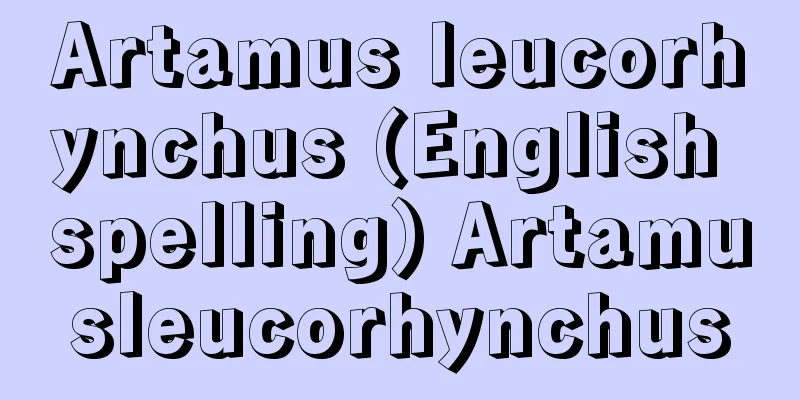Michelangelo - Michelangelo Buonarroti

|
Italian sculptor, painter, architect, and poet. Born in Caprese, central Italy (March 6th), 23 years after Leonardo da Vinci and 8 years before Raphael, he died in Rome at the age of 89 (February 18th) after a long career in the late Italian Renaissance. His grave is in the Basilica of Santa Croce in Florence. His artistic legacy includes about 40 sculptures, four large murals, a few tableaux, and architectural designs and decorations for churches and monuments. In addition, about 800 studies, drawings, and sketches related to these paintings, sculptures, and architecture are scattered around the world. He also wrote about 300 poems from his youth, and more than 500 letters addressed to relatives, friends, and acquaintances are still handed down to the present day. [Susumu Kazuhiro] SculptureHe first studied under the Florentine painter Ghirlandaio, but from the age of 14, under the patronage of the Medici family, he became a pupil of the sculptor Bertoldo di Giovanni, at which point he studied the ancient sculptures in the Medici collection. From then on, he devoted himself to sculpture, and maintained a lifelong awareness of himself as a sculptor. His works from his apprenticeship include "Madonna of the Stairs" and "Centauromachy" (both at Casa Buonarotti, Florence), which show a clear influence from the Florentine sculptor Donatello and ancient sculptures. In 1496, at the age of 21, he went to Rome to create "Dionysus" (Bargello National Museum, Florence), followed by "Pieta" (St. Peter's Basilica). This "Pieta" is the only work that bears Michelangelo's signature on the sash draped around the Virgin's chest. In 1501, he returned to Florence and was commissioned by the city authorities to create the statue of David, which took about three and a half years to complete. There were various opinions about where to place the statue, but the sculptor's wishes were accepted and it was placed in front of the Palazzo Vecchio, where it was considered a symbol of the autonomous city of Florence (the original is currently housed in the Accademia Gallery in the same city). The statue was made from an old, failed block of marble, so by creating a living David from dead marble, it was literally his debut work. Two medallions called tondos, the Pitti Madonna and Child (Bargello National Museum) and the Taddei Madonna and Child (Royal Academy, London), were also created around the same time. Michelangelo was 30 years old when he was commissioned by the Pope to create the Mausoleum of Julius II in 1505. The original plan was for a majestic tomb to be placed inside St. Peter's Basilica on a rectangular base measuring 7.6 x 11.3 meters, with 40 statues of over life-size figures placed on it. The Dying Slave, The Rebellious Slave (both in the Louvre), the Triumph (Palazzo Vecchio), and the Young Slave, The Bearded Slave, The Slave of Atlas, and The Awakening Slave, all now in the Galleria dell'Accademia in Florence, were all created to decorate the monument. The Mausoleum of Julius II was gradually scaled down after the death of the Pope, and the one that remains today is the fifth contract of Michelangelo, who was created at the age of 67, and is located in the Basilica of San Pietro in Vincoli in Rome. The three statues on the lower level of the tomb ("Moses" in the center, "Racelle" on the left, and "Leah" on the right) are his handiwork. In 1513, following the death of Julius II, Leo X, a member of the Medici family, ascended to the throne. In 1520, at the age of 45, he was commissioned to create a tomb for the Medici family in the New Sacristy of San Lorenzo, the Medici family temple. Since then, Michelangelo was caught between the Rovere family of Rome, the surviving relatives of Julius II, and the Medici family of Florence, traveling between the two cities and working like a horse to create statues. Condivi, author of the Life of Michelangelo, calls Michelangelo's situation at this time the "tragedy of the tomb." The Medici Mausoleum has statues and sarcophagi of Lorenzo (Duke of Urbino) on the left and Giuliano (Duke of Nemours) on the right, facing the altar of the New Sacristy, with two allegorical figures on each sarcophagus. The sarcophagus of Lorenzo features statues of Dawn and Evening, while the sarcophagus of Giuliano features statues of Day and Night, both about two meters long. Opposite the altar is a Madonna and Child. Michelangelo was obsessed with creating a Pieta statue from a young age, and in addition to the aforementioned "Pieta" in St. Peter's, he also created the "Pieta" in Florence Cathedral and the "Rondanini Pieta" in the Castello Sforzesco in Milan. The "Pieta" in Florence was created when he was about 75 years old, but it was abandoned midway and later given its present-day form by a disciple, which is why Mary Magdalene on the far left has lost her proportions. The face of Nicodemus in the center at the back is said to be a self-portrait of Michelangelo. The "Rondanini Pieta" is an unfinished statue that Michelangelo is said to have worked on until six days before his death, and the polished legs and left hip of Jesus, as well as the right arm remaining at a distance, are likely based on the original plan. The form of this Pieta is unusual, with the dead Jesus standing and carrying the living Mary on his back, and is thought to represent the crystallization of the master's faith, art, and philosophy in his later years. [Susumu Kazuhiro] PaintingIn 1504, the same year that Michelangelo completed his David statue, he was commissioned by the city of Florence to paint a large mural, The Battle of Cascina, for the Palazzo Vecchio. This was meant to be a competition with Leonardo's Battle of Anghiari, both of which were to decorate the same conference room, but due to various circumstances, both projects were abandoned without progress being made, and today only a few sketches and copies remain. Michelangelo was commissioned by Pope Julius II to paint the large fresco murals in the Sistine Chapel. The difficult task of painting on the ceiling while lying face-up and not being proficient in fresco techniques led him to complain in letters to his relatives about the difficulties of "Michelangelo the sculptor painting murals." The nine scenes on the ceiling, starting with the Creation (13 meters wide, 40 meters deep), were painted over three years from 1508 when he was 33 years old, and the Last Judgment (14.5 meters by 13 meters) on the front of the same chapel was painted over five and a half years from 1536 to 1541 at the request of Pope Paul III, about 30 years later. The Last Judgment, with a giant-like "Angry Christ" reigning in the center, depicts nearly 400 people, including saints, souls to be saved, and souls to be punished. The dynamic composition and expression of the rotating group of figures, with souls ascending to heaven on the left and souls falling into hell on the right, show the breakdown of the classical Renaissance style and a transition to the passionate Baroque style. Other murals include the Conversion of Paul (1545?) and the Crucifixion of Peter (1550) in the Paolina Chapel in the Vatican, and a tempera circlet, the Holy Family (Uffizi), c.1504-06, is particularly noteworthy for its careful compositional considerations and careful drawing technique. [Susumu Kazuhiro] ArchitectureMichelangelo's first architectural work was when, at the age of 41 in 1516, he was commissioned by Pope Leo X to decorate the façade of San Lorenzo in Florence. He then worked on the interior design of the Laurentian Library in San Lorenzo and the staircase (around 1524-26), and in 1535 was appointed Inspector General of Architecture, Sculpture and Painting for the Papal State. In 1547, he became the chief architect of St. Peter's Basilica, producing a wooden model of the great dome. He also participated in the design of the Piazza del Campidoglio, Porta Pia and Palazzo Farnese in Rome. [Susumu Kazuhiro] "Michelangelo's Drawings" edited by Susobun Kazuhiro (1973, Iwasaki Bijutsusha)" ▽ "Michelangelo, 3 volumes by F. Hart, translated by Kubo Hiroji (1973-75, Bijutsu Shuppansha)" ▽ "World Sculpture Art Collection 9: Michelangelo, commentary by Tominaga Soichi (1975, Shogakukan)" ▽ "World Art Collection 6: Michelangelo, commentary by Yoshikawa Itsuji and Tanaka Hidemichi (1975, Shueisha)" ▽ "Michelangelo's Architecture, by J.S. Ackerman, translated by Nakamori Yoshimune (1976, Shokokusha)" ▽ "Michelangelo: A Biography with Poems and Letters by Condivi, translated by Takada Hiroatsu (1978, Iwasaki Bijutsusha)" ▽ "The Life of Michelangelo" by Romain Rolland, translated by Takada Hiroatsu (Iwanami Bunko)" ▽ "Michelangelo - Sculptor, Painter, Architect" by Tornai, translated by Tanaka Hidemichi (1978, Iwanami Shoten)" ▽ "World Biography Series 6: Michelangelo" by Colombier et al., translated by Wakakuwa Takeshi and Wakakuwa Midori (1983, Shogakukan)" ▽ "Illustrated Michelangelo" by Aoki Akira (1997, Kawade Shobo Shinsha)" ▽ "Michelangelo's World View" by Tanaka Hidemichi (1999, Tohoku University Press)" ▽ "Michelangelo" by Tanaka Hidemichi (Kodansha Academic Library)" ▽ "The Sistine Chapel and Michelangelo" by Ross King, translated by Tanabe Kikuko (2004, Tokyo Shoseki)" [References] | | | Judgment| | | |Source: Shogakukan Encyclopedia Nipponica About Encyclopedia Nipponica Information | Legend |
|
イタリアの彫刻家、画家、建築家、詩人。レオナルド・ダ・ビンチに遅れること23年、ラファエッロより8年早く、中部イタリアのカプレーゼに生まれ(3月6日)、イタリア・ルネサンス晩期に長らく活躍のすえ、89歳でローマに没(2月18日)。フィレンツェのサンタ・クローチェ聖堂内に墓がある。芸術上の遺作は、彫刻作品約40点、絵画では4面の大壁画のほか、若干のタブロー、建築では教会や記念建造物などの設計や装飾を残し、また、これらの絵画、彫刻、建築に関するおびただしい習作、素描、エスキスのたぐい約800点が、世界各地に分散して伝えられている。また、詩作は若いころからおよそ300編があり、そのほか、親族や友人・知己にあてた500通を超える書簡が今日に伝わる。 [裾分一弘] 彫刻初め、フィレンツェの画家ギルランダイヨに師事するが、14歳のときからメディチ家の保護を得て、彫刻家ベルトルド・ディ・ジョバンニの門に入り、かたわらメディチ家収集の古代彫刻を研究、以来彫刻に専念して、彫刻家としての自覚を生涯もち続けることになる。徒弟時代の作品には、『階段の聖母』『ケンタウロマキア』(ともにフィレンツェ、カサ・ブオナロッティ)があり、フィレンツェの彫刻家ドナテッロや古代彫刻からの影響が顕著である。1496年、21歳でローマに出て、『ディオニソス』(フィレンツェ、バルジェッロ国立美術館)、続いて『ピエタ』(サン・ピエトロ大聖堂)を制作。この『ピエタ』は、聖母の胸にかけられた襷(たすき)にミケランジェロの署名を残す唯一の作品である。 1501年フィレンツェに帰り、市当局の委嘱を受けて『ダビデ』像の制作にかかり、3年半ほどの歳月をかけて完成。この像の設置場所に関し種々の意見があったが、制作者の希望がいれられてパラッツォ・ベッキオ前に置かれ、自治都市フィレンツェの象徴とみなされた(現在原作は同市アカデミア美術館に収蔵)。像は古い失敗作の大理石塊を素材としており、したがって死せる大理石から生けるダビデを制作したことにより、文字どおりのデビュー作となった。トンドとよばれる2個の円形浮彫り『ピッティの聖母子』(バルジッェロ国立美術館)、『タッデイの聖母子』(ロンドン、ロイヤル・アカデミー)もほぼ同時期の制作である。 ミケランジェロがユリウス2世廟(びょう)の制作を教皇から依頼されたのは、1505年30歳のときである。当初のプランでは、墓廟は7.6メートル×11.3メートルの長方形台座の上に立ち、それに等身大以上の彫像40体が置かれて、サン・ピエトロの堂内に安置されるはずの雄大な構想であった。『瀕死(ひんし)の奴隷』『反抗する奴隷』(ともにルーブル美術館)、『勝利』(パラッツォ・ベッキオ)、および今日フィレンツェのアカデミア美術館収蔵の『若い奴隷』『髭(ひげ)の奴隷』『アトラスの奴隷』『目ざめる奴隷』などは、このモニュメントを飾るために制作されたものである。ユリウス2世廟は、教皇なきあとその規模がしだいに縮小されて、今日その名で残る構想は第五次契約によるミケランジェロ67歳の制作で、ローマのサン・ピエトロ・イン・ビンコリ聖堂内にある。墓廟下段の3点(中央の『モーセ』、左の『ラケル』、右の『レア』)が彼の手になる彫像である。 1513年、ユリウス2世の逝去に伴い、メディチ家から出たレオ10世が即位し、20年45歳のとき、メディチ家の菩提寺(ぼだいじ)サン・ロレンツォの新聖器室にメディチ家の墓廟の制作を依頼されることになる。以来ミケランジェロはユリウス2世の遺族であるローマのロベレ家と、フィレンツェのメディチ家の板挟みのなかで両市の間を行き来し、馬車馬のように彫像の制作に励む。『ミケランジェロ伝』の作者コンディビは、この時期のミケランジェロの状況を「墓廟の悲劇」とよんでいる。メディチ廟は、新聖器室の祭壇に向かって左にロレンツォ(ウルビーノ公)、右にジュリアーノ(ヌムール公)の彫像および石棺が置かれ、各石棺の上にそれぞれ2体の寓意(ぐうい)像がのる。すなわちロレンツォの石棺には『曙(あけぼの)』と『夕』、ジュリアーノには『昼』と『夜』の、いずれも体長約2メートルの彫像である。また祭壇の向かいには『聖母子』が置かれている。 ミケランジェロは若いころからピエタ像の制作に執念を抱き、前記サン・ピエトロの『ピエタ』のほかに、フィレンツェ大聖堂の『ピエタ』、ミラノのカステロ・スフォルツェスコの『ロンダニーニのピエタ』を残している。フィレンツェの『ピエタ』は75歳のころの制作であるが、中途放棄され、のち弟子の手によって今日の状態に仕上げられたため、左端のマグダラのマリアは比例を失っている。後方中央のニコデモの顔は、ミケランジェロの自像であるという。『ロンダニーニのピエタ』は、ミケランジェロが死の6日前まで鑿(のみ)を振るっていたことが伝えられる未完の彫像で、磨かれているイエスの両脚と左腰、離れた位置に残されている右腕は当初の案による制作であろう。このピエタの像形は異例のもので、死せるイエスが生けるマリアを背負って立つポーズであり、巨匠晩年の信仰、芸術、哲学の結晶した境地を示すと思われる。 [裾分一弘] 絵画ミケランジェロは1504年、『ダビデ』像を完成した年、フィレンツェのパラッツォ・ベッキオに『カッシーナの戦い』の大壁画を描く依頼を市から受けた。これは先輩レオナルドの『アンギアリの戦い』とともに、同じ会議室を飾る競作となるはずであったが、諸般の事情で双方とも進捗(しんちょく)しないまま中断し、今日では若干の素描と模写を残すのみである。 ミケランジェロがシスティナ礼拝堂内にフレスコの大壁画を描くことになったのは、やはり教皇ユリウス2世の委嘱による。フレスコの技法に習熟せず、かつあおむいて天井に描くという難事業で、彼は肉親への手紙で「彫刻家ミケランジェロが壁画を描く」苦衷を訴えている。天井画の天地創造に始まる9場面(幅13メートル強、奥行40メートル強)は、33歳の1508年から約3年、また同じ堂内正面の『最後の審判』(約14.5メートル×13メートル)は約30年後、パウルス3世の依嘱により36年から41年まで5年半の歳月をかけて描かれたものである。巨人のような「怒れるキリスト」が中央に君臨する最終審判図では、諸聖者のほか、救われる魂、罰せられる魂、あわせて400名近くが描かれる。左の天国へ昇る魂と右の地獄へ落ちる魂との、大きく回転する群像の動的構図と動的表現は、ルネサンスの古典様式が解体し、激情的なバロック様式への推移をみせている。 その他の壁画には、バチカンのパオリーナ礼拝堂の『パウロの改宗』(1545?)と『ペテロの磔刑(たっけい)』(1550)がある。また、1504~06年ごろのテンペラによる円形画『聖家族』(ウフィツィ美術館)は、綿密な構図上の配慮と入念な描法により、とくに注目すべき作品である。 [裾分一弘] 建築ミケランジェロが建築の仕事に携わるのは、1516年41歳のとき、レオ10世からフィレンツェのサン・ロレンツォ聖堂のファサード装飾を命じられたのが最初である。その後、サン・ロレンツォ内ラウレンティアーナ図書室の内装、階段の設計(1524~26ころ)に携わり、35年には教皇庁の建築、彫刻、絵画総監に任ぜられている。47年、サン・ピエトロ大聖堂の造営主任となって、大円蓋(えんがい)の木製模型を制作し、そのほかローマでは、カンピドリオ広場、ポルタ・ピア、ファルネーゼ宮の設計にも関与している。 [裾分一弘] 『裾分一弘編著『ミケランジェロの素描』(1973・岩崎美術社)』▽『F・ハート著、久保尋二訳『ミケランジェロ』全3冊(1973~75・美術出版社)』▽『富永惣一解説『世界彫刻美術全集9 ミケランジェロ』(1975・小学館)』▽『吉川逸治・田中英道解説『世界美術全集6 ミケランジェロ』(1975・集英社)』▽『J・S・アッカーマン著、中森義宗訳『ミケランジェロの建築』(1976・彰国社)』▽『コンディヴィ著、高田博厚訳『ミケランジェロ伝――付ミケランジェロの詩と手紙』(1978・岩崎美術社)』▽『ロマン・ロラン著、高田博厚訳『ミケランジェロの生涯』(岩波文庫)』▽『トルナイ著、田中英道訳『ミケランジェロ――彫刻家・画家・建築家』(1978・岩波書店)』▽『コロンビエ他著、若桑毅・若桑みどり訳『世界伝記双書6 ミケランジェロ』(1983・小学館)』▽『青木昭著『図説ミケランジェロ』(1997・河出書房新社)』▽『田中英道著『ミケランジェロの世界像』(1999・東北大学出版会)』▽『田中英道著『ミケランジェロ』(講談社学術文庫)』▽『ロス・キング著、田辺希久子訳『システィナ礼拝堂とミケランジェロ』(2004・東京書籍)』 [参照項目] | | | | | | |出典 小学館 日本大百科全書(ニッポニカ)日本大百科全書(ニッポニカ)について 情報 | 凡例 |
<<: Michelis (Callosciurus prevosti)
>>: Pretrial detention - Miketsu Koryu
Recommend
Teaching - Kyokai
Year of death: May 28, 1093 (June 24, 1093) Year o...
Epistēme (Greek: episteme)
Greek word meaning "knowledge". In anci...
Perboric Acid - Kahousan
...A general term for compounds in which the oxyg...
All Japan Post March Struggle
The Zentei Union took the lead in fighting for wag...
Kadoma [city] - Kadoma
A city in central Osaka Prefecture. It was incorpo...
Patellar tendon reflex
When the patellar tendon is tapped, the quadricep...
depot fat
...Cholesterol is an important component of anima...
Deposit system - Azukarikinseido
...The Japanese-Portuguese Dictionary, which incl...
Japan Tourist Bureau
...The world's largest travel agency, which h...
Kizugawa
A tributary of the Yodo River that flows through s...
Vaux-le-Vicomte (English spelling)
...He particularly made use of the canals (waterw...
Costus (English spelling) spiral flag
It is a perennial plant of the Costus genus of the...
Leovigild
...This made it possible to form a political syst...
Haikai Mougyū
A treatise on haiku by Ichichu. Published in 1675 ...
Paper money - Shihei (English spelling)
Paper currency such as government notes and bank ...




![Kukizaki [town] - Kukizaki](/upload/images/67cb670ab41e1.webp)




